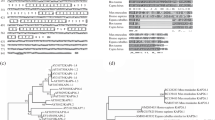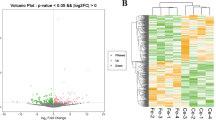Abstract
Keratin-associated protein is one of the major structural proteins of the hair, whose content in hair has important effect on the quality of cashmere. In order to study the relationship between HGTKAP gene expression and cashmere fineness, the quantitative real-time RT–PCR (qRT–PCR) was firstly used to detect the levels of KAP7.1, KAP8.2 gene expression in the primary and secondary hair follicles; semi-quantitative RT–PCR was used to detect whether KAP7.1, KAP8.2 gene are expressed in heart, liver, spleen, lung, kidney tissues; and in situ hybridization(ISH) to detect KAP7.1 gene expression location. qRT–PCR result showed that the expression of both KAP7.1 and KAP8.2 gene in the secondary hair follicles are significantly higher than that in the primary follicles, relative quantitative analysis obtained that KAP7.1 was 2.28 times, while KAP8.2 was 2.71 times. Semi-quantitative RT–PCR results revealed that KAP 7.1 and KAP8.2 mRNA were not detected in the heart, liver, spleen, lung and kidney tissues, demonstrating that KAP7.1 and KAP8.2 were specially expressed in hair follicles, participating in hair formation. Moreover, KAP7.1 gene has a strong expression in the cortical layer, inner root sheath of the primary follicles and the cortical layer, inner root sheath and hair matrix of the secondary hair follicles by ISH analysis. Taken together, the evidence presented here indicated that in the formation of cashmere and wool, differential expression of these two genes in the primary and secondary hair follicles may have an important role in regulating the fiber diameter.


Similar content being viewed by others
Abbreviations
- KAP:
-
Keratin-associated protein
- qRT–PCR:
-
Quantitative real-time PCR
- PCR:
-
Polymerase chain reaction
- ISH:
-
In situ hybridization
- PF:
-
Primary hair follicle
- SF:
-
Secondary hair follicle
References
Langbein L, Rogers MA, Winter H et al (2001) The catalog of human hair keratins. J Biol Chem 276:35123–35132
Rogers MA, Langbein L, Winter H et al (2002) Characterization of a first domain of human high glycine–tyrosine and high sulfur keratin-associated protein (KAP) genes on chromosome 21q22.1. J Biol Chem 277:48993–49002. doi:10.1074/jbc.M206422200
Yin J, Hu TM, Li JQ (2004) Cloning and analysis of six full-length cDNA similar to sheep KAP6-1 from cashmere goat. Acta Genet Sin 31:502–507
Jeffrey EP, Warren GB (2000) Application of proteomics for determining protein markers for wool quality traits. Electrophoresis 21:1899–1906. doi:10.1002/(SICI)1522-2683(20000501)21:9<1899:AID-ELPS1899>3.0.CO;2-R
Rogers GE (2004) Hair follicle differentiation and regulation. Int J Dev Biol 48:163–170
Powell BC, Rogers GE (1986) Hair keratin: composition, structure and biogenesis. Biol Integument 2:696–721
Parsons YM, Cooper DW (1994) Evidence of linkage between high-glycine–tyrosine keratin gene loci and wool fibre diameter in a Merino half-sib family. Anim Genet 25:105–108
Zhao J, Ren Y, Yue W (2007) Analysis of polymorphism on KAP8 gene in three goat breeds with PCR-SSCP. Biotechnology 17(5):3–6
Zhao M, Chen H, Wang X (2008) PCR-SSCP and DNA sequencing detecting two silent SNPs at KAP8.1 gene in the cashmere goat. Mol Biol Rep 36:1387–1391. doi:10.1007/s11033-008-9325-1
Liu GF, Tian KC, Zhang EP (2007) Candidate gene analysis of high quality merino sheep. Hereditas 29:70–74. doi:10.1360/yc-007-0070
Jin M, Fu ZY, Luan YY (2006) Cloning and evolution analysis of ZFX, ZFY partial gene in new-breeding cashmere goat and identification of its sex. Acta Vet Zootech Sin 37(6):530–536
Jin M, Cui YH, Fu ZY et al (2006) The correlation analysis of blood protein polymorphism with economics traits in Liaoning new-breeding cashmere goat. Hereditas (Beijing) 28(5):529–532
Li CQ, Yin J, Zhang YJ et al (2005) Comparative study on skin and hair follicles cycling between Inner Mongolia and Liaoning cashmere goats. Acta Vet Zootech Sin 36(7):674–679
Aoki N, Ito M (1997) Isolation and characterization of mouse high-glycine/tyrosine proteins. J Biol Chem 272(48):30512–30518
Shu WL, Ouyang HS, Rogers GE, Bawden CS (2009) Characterization of the structural and molecular defects in fibres and follicles of the merino felting luster mutant. Exp Dermatol 18:134–142. doi:10.1111/j.1600-0625.2008.00774.x
Cui ZF, Zhao J, Wang H (2008) Influences of different mediums on goat hair follicles cultured in vitro. Journal of Shandong Univ (Nat Sci) 43(5):1–5
Zhang JX, Yin J (2006) Expression of KAP7.1 gene in the inner mongolian cashmere goat skin. China herbivores. pp 76–77
Rogers MA, Langbein L, Praezel-Wunder S, Giehl K (2008) Characterization and expression analysis of the hair keratin associated protein KAP26.1. Br J Dermatol 159:725–729. doi:10.1111/j.1365-2133.2008.08743.x
Powell BC, Rogers GE (1997) The role of keratin proteins and their genes in the growth, structure and properties of hair. EXS 78:59–148
Rogers MA, Langbein L, Praetzel-Wunder S, Winter H, Schweizer J (2006) Human hair keratin associated proteins (KAPs). Int Rev Cytol 251:209–263. doi:10.1016/soo74-7696(06)51006-x
Kariya N, Shimomura Y, Ito M (2005) Size polymorphisms in the human ultrahigh sulfur hair keratin-associated protein 4, KAP4, gene family. J Investig Dermatol 124(6):1111–1118. doi:10.1111/j.0022-202x.2005.23662.x
Rogers MA, Winter H, Langhein L et al (2007) Characterization of human KAP24.1, a cuticular hair keratin-associated protein with unusual amino-acid composition and repeat structure. J Investig Dermatol 127:1197–1204. doi:10.1038/sj.jid5700702
Bawden CS, Powell BC, Walker SK, Rogers GE (1998) Expression of a wool intermediate filament keratin transgene in sheep fibre alters structure. Transgenic Res 7(4):273–287. doi:10.1023/A:1008830314386
Jave-Suarez LF, Winter H, Langbein L (2002) HOXC13 is involved in the regulation of human hair keratin gene expression. J Biol Chem 277(5):3718–3726
Acknowledgment
This work was supported by National Natural Science Foundation of China (No. 30571324 and 30972079), the Natural Science Fund of Liaoning Province (No. 20072151), and Science and technology plan project of Dalian (No. 2008B12NC079).
Author information
Authors and Affiliations
Corresponding author
Electronic supplementary material
Below is the link to the electronic supplementary material.
Rights and permissions
About this article
Cite this article
Jin, M., Wang, L., Li, S. et al. Characterization and expression analysis of KAP7.1, KAP8.2 gene in Liaoning new-breeding cashmere goat hair follicle. Mol Biol Rep 38, 3023–3028 (2011). https://doi.org/10.1007/s11033-010-9968-6
Received:
Accepted:
Published:
Issue Date:
DOI: https://doi.org/10.1007/s11033-010-9968-6




